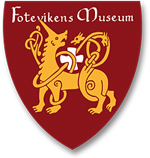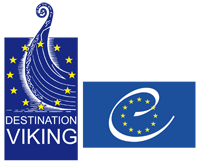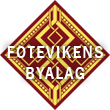The Battle of Foteviken in 1134

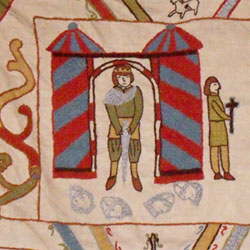 Scania in the early 12th century AD. The bread basket of Denmark. King Erik with the surname Ejegod - the always good - has ruled since 1095. It has been a happy period for the country. He is now, in the year 1103 AD, a 46 year old man, married to Bodil, daughter of the norweigan jarl Thrugot Fairskin. It is a pious man who this year says his fairwells to bishop Ascer in Lund. Five years earlier he journeyed the long way down through Europe to Italy for a personal meeting with the Pope. In Bari he met Urban II and was promised that his brother Knut, murdered in the church of Odense in 1086 AD, would be declared a saint. The Pope also promised that Scandinavia would be detached from the German Hamburg - Bremen archdiocese and form a diocese of its own with Lund as centre of the church. It was a happy Danish king - Erik Ejegod - the always good - who then in 1098 AD, had journeyed home over the Alps and through the large kingdom of the german emperor.
Scania in the early 12th century AD. The bread basket of Denmark. King Erik with the surname Ejegod - the always good - has ruled since 1095. It has been a happy period for the country. He is now, in the year 1103 AD, a 46 year old man, married to Bodil, daughter of the norweigan jarl Thrugot Fairskin. It is a pious man who this year says his fairwells to bishop Ascer in Lund. Five years earlier he journeyed the long way down through Europe to Italy for a personal meeting with the Pope. In Bari he met Urban II and was promised that his brother Knut, murdered in the church of Odense in 1086 AD, would be declared a saint. The Pope also promised that Scandinavia would be detached from the German Hamburg - Bremen archdiocese and form a diocese of its own with Lund as centre of the church. It was a happy Danish king - Erik Ejegod - the always good - who then in 1098 AD, had journeyed home over the Alps and through the large kingdom of the german emperor.
In 1101 AD the Pope fulfilled one of his promises. The former king Knut was written into the holy book and appointed Danish national saint - an important step for Denmark to become the archdiocese of Scandinavia. A proof that it was a pious kingdom fully submitted to the Christian authority in Rome; a kingdom with a people that had rejected their old pagan worship. But also proof that Denmark now was the cultural centre of Scandinavia. And now, in the year 1103 AD, king Erik shakes the hand of bishop Ascer in Lund and leaves Denmark. He and his wife Bodil are to leave on a pilgrimage to the holy grave in Jerusalem to return next year and participate in the ceremony when Ascer is inaugurated as the first arch-bishop of Scandinavia.
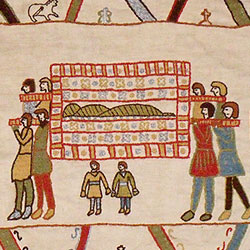 But... he would never return home. On the 10th of July Erik dies of fever in Paphos on Cyprus. Bodil continues on to the holy city but dies on the Mount of Olives and is buried in the Valley of Josaphat. Instead Erik's brother Niels is present when cardinal Alberich, the Pope's envoy, in 1104 AD in Lund bestows Ascer the pallium, the symbol of office of the arch-bishop in the form of a broad cloth scarf with embroidered crosses made of the wool from holy sheep. Ascer is now arch-bishop of the whole of Scandinavia. Scania has become a cultural centre in Europe.
But... he would never return home. On the 10th of July Erik dies of fever in Paphos on Cyprus. Bodil continues on to the holy city but dies on the Mount of Olives and is buried in the Valley of Josaphat. Instead Erik's brother Niels is present when cardinal Alberich, the Pope's envoy, in 1104 AD in Lund bestows Ascer the pallium, the symbol of office of the arch-bishop in the form of a broad cloth scarf with embroidered crosses made of the wool from holy sheep. Ascer is now arch-bishop of the whole of Scandinavia. Scania has become a cultural centre in Europe.
Troubled times would however soon reach Scania. Following the death of Erik Ejegod on his pilgrimage, his brother Niels took the throne. Niels had a son, Magnus, who was afraid the son of the dead king Erik, Knut Lavard, would take the crown from him when Niels died. Magnus thus decided to murder his cousin in a cunningly arranged ambush.
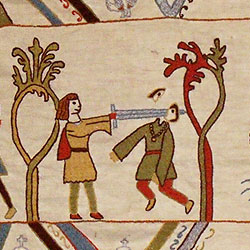 On the 7th of January 1131 AD prince Magnus arranged a meeting with his cousin in a forest between Roskilde and Ringsted. A contemporary chronicle tells:
On the 7th of January 1131 AD prince Magnus arranged a meeting with his cousin in a forest between Roskilde and Ringsted. A contemporary chronicle tells:
"As the holy man Knud was about to stand, the traitor (Magnus) shamefully pulled him back by the hood of his cloak and with his drawn sword he cleft Knud's head from the left ear to the right eye, his ungodly cut made the victim's brain pour out. Now Henrik ran up and drove his spear through the innocent body. Thereafter the remaining participants of this crime stabbed their spears into the chest of the duke.
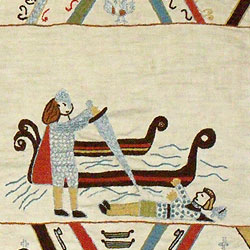 The younger brother of Knut Lavard, Erik Emune, was not happy when he learned that they had made minced meat of his brother, well minced meat one might dare add judging by the contemporary description. He now took up arms and was backed by the Scanians, including arch-bishop Ascer in Lund. The german arch-bishop in Bremen had demanded from the german emperor that Scandinavia should once again be placed under Bremen supremacy. To gain - or rather buy - the favor of the emperor, king Niels approved of this. During the Easter in 1134 Niels son Magnus, the murderer, visited the german emperor in Halberstadt about 40 miles south into Germany.
The younger brother of Knut Lavard, Erik Emune, was not happy when he learned that they had made minced meat of his brother, well minced meat one might dare add judging by the contemporary description. He now took up arms and was backed by the Scanians, including arch-bishop Ascer in Lund. The german arch-bishop in Bremen had demanded from the german emperor that Scandinavia should once again be placed under Bremen supremacy. To gain - or rather buy - the favor of the emperor, king Niels approved of this. During the Easter in 1134 Niels son Magnus, the murderer, visited the german emperor in Halberstadt about 40 miles south into Germany. 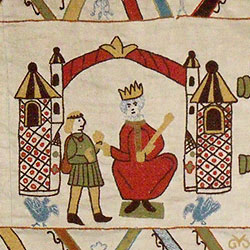 Magnus emerged and praised the emperor as his lord, and in return received the crown of Denmark from the hand of the emperor. With the crown on his head and sword drawn he then walked ahead of the emperor in the solemn procession. He had now sold out his country and his arch-bishop for his own personal gain.
Magnus emerged and praised the emperor as his lord, and in return received the crown of Denmark from the hand of the emperor. With the crown on his head and sword drawn he then walked ahead of the emperor in the solemn procession. He had now sold out his country and his arch-bishop for his own personal gain.
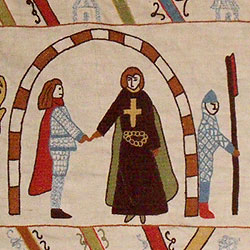 Erik Emune on the other hand strongly opposed the friendship with the emperor. Thus the choice was easy for arch-bishop Ascer in Lund. Unless he joined the insurgent Erik Emune he would lose his arch-bishop title. Scania and the Scanian church thus mobilized for war.
Erik Emune on the other hand strongly opposed the friendship with the emperor. Thus the choice was easy for arch-bishop Ascer in Lund. Unless he joined the insurgent Erik Emune he would lose his arch-bishop title. Scania and the Scanian church thus mobilized for war.
King Niels and his son Magnus gathered the danish fleet to sail across Öresund and recapture Scania. The historian Saxo tells that the entire Danish fleet, except the Scanian, was gathered. To Danish rulers it has always been essential to hold control of the fleet. Denmark is made up of a number of islands and the warships were the means of controlling them. Thus it would have been essential for Niels to claim the Scanian fleet. It was anchored in the war harbor in the bay of Foteviken. Thus it was natural for the invasion to be made here. Halör, one of the largest marketplaces in Scandinavia, was also located by Foteviken.
The Danish fleet was assembled by the eastern coast of Zealand. Saxo tells how king Niels gave orders for all his soldiers to keep guard along the coast so that no one could make it across to provide Erik with useful knowledge. However a man named Magnus Saxeson was lowered by a long rope from Stevn's Cliffs and made his way over to Scania by night, "where he did Erik a large favor".
On the morning of the 4th of June 1134 king Niels made landfall at Foteviken. The only stretch of coast where the landing would be possible is from the current day Falsterbo channel in the north to a few hundred meters north of Foteviken Museum.
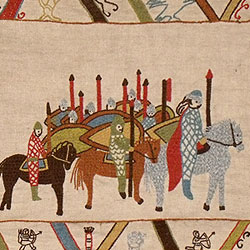 The water is shallow and the entire coast up to Malmö is coated with large rocks far out into the water. Only on this short stretch of coast the sandy seabed was free of rocks, which would be a requirement for an invasion.
The water is shallow and the entire coast up to Malmö is coated with large rocks far out into the water. Only on this short stretch of coast the sandy seabed was free of rocks, which would be a requirement for an invasion.
Erik Emune however had acquired a few hundred horsemen. Armed cavalry was at the time a new innovation in warfare. Large scale cavalry charges had rarely ever been used in Scandinavia before. These horsemen along with the Scanians had a decisive impact in favor of Erik's victory at Foteviken.
The description of Saxo Gramaticus, about 1200 AD
The Danish historian Saxo wrote about the events at Foteviken in 1134 AD. He must have heard of it from people who lived at the time it transpired, or maybe he was even present at the battle himself.
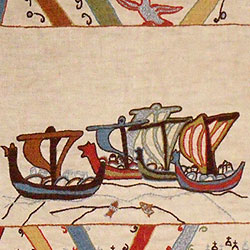 "The following summer Niels gathered the entire Danish fleet, save the Scanian, and sailed to Foteviken, where he he arrayed his army on the beach, and thus was left standing still for a short while as Erik advanced. But when he spotted the horses in the distance whirl up the dust with their hooves like a cloud, he gradually fell back toward his ships, and when he heard the roar of the the advancing horsemen he fled. When Erik caught up to the army it was already defeated, not in battle but by fate, and without suffering any casualties himself he cut them down and gained a victory, which cost him no blood, as God avenged the family murder.
"The following summer Niels gathered the entire Danish fleet, save the Scanian, and sailed to Foteviken, where he he arrayed his army on the beach, and thus was left standing still for a short while as Erik advanced. But when he spotted the horses in the distance whirl up the dust with their hooves like a cloud, he gradually fell back toward his ships, and when he heard the roar of the the advancing horsemen he fled. When Erik caught up to the army it was already defeated, not in battle but by fate, and without suffering any casualties himself he cut them down and gained a victory, which cost him no blood, as God avenged the family murder.
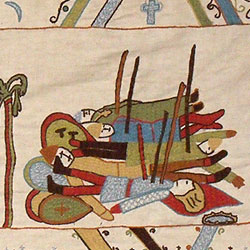 Only Magnus, who with a small group of brave men refused to flee, turned upon their enemy and tried to drive him back while the others turned their back; for he realised that the chance of escape was slim, and he made it an honor to bravely seek death and make his end praiseworthy by falling in battle. He preferred death to escape to not spoil his reputation for bravery. Finally, after fighting bravely and felling a number of foes, he fell on top of the pile of corpses he had amassed around him, along with bishop Peder of Roskilde, and as he followed him in death they ended up in the same grave.
Only Magnus, who with a small group of brave men refused to flee, turned upon their enemy and tried to drive him back while the others turned their back; for he realised that the chance of escape was slim, and he made it an honor to bravely seek death and make his end praiseworthy by falling in battle. He preferred death to escape to not spoil his reputation for bravery. Finally, after fighting bravely and felling a number of foes, he fell on top of the pile of corpses he had amassed around him, along with bishop Peder of Roskilde, and as he followed him in death they ended up in the same grave.
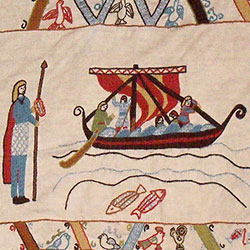 Niels rushed back to his own ship on a horse a farmer had provided him. As most of the fleeing soldiers grabbed onto the thwarts and clung to the ships to get aboard some ships were close to sinking due to the great weight. Thus those who had first gotten aboard, disregarding any friendship, cut the hands off those clinging to the ships with their swords, thus they were more cruel to their own than they had been to the enemy. In no other battle more bishop blood has been spilled, as bishop Peder of Roskide, the Swedish bishop Henrik and all the Jutland bishops except one perished in the battle." (six bishops in all)
Niels rushed back to his own ship on a horse a farmer had provided him. As most of the fleeing soldiers grabbed onto the thwarts and clung to the ships to get aboard some ships were close to sinking due to the great weight. Thus those who had first gotten aboard, disregarding any friendship, cut the hands off those clinging to the ships with their swords, thus they were more cruel to their own than they had been to the enemy. In no other battle more bishop blood has been spilled, as bishop Peder of Roskide, the Swedish bishop Henrik and all the Jutland bishops except one perished in the battle." (six bishops in all)
Epilogue
After winning the battle, had Erik in a dramatic way taken over regency of all of Denmark. Erik then got the surname Emune, "the memorable."
Erik was hailed as the king over Skåne and Denmark at St Liber's mound at Lund in June 25th, 1134. He took Lund as seat and made ​​the city the capital of Denmark.
However, it was not a lasting regime, three years later July 18th, 1137 Erik was killed on County Council Urnhoved near Ribe by the greatman Sorte Plov and was buried in Ribe Cathedral. On September 18th 1137 Erik was succeeded by his sisters son Erik Lamm as king and therewith was Lund time as the capital of Denmark over.

